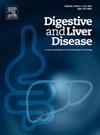胆道闭锁和肝移植:新肝,延长寿命
IF 3.8
3区 医学
Q1 GASTROENTEROLOGY & HEPATOLOGY
引用次数: 0
摘要
胆道闭锁(BA)实际上是儿童肝移植(PLT)最常见的适应症,至少占全球PLT总量的50%。这是一项回顾性单中心研究,旨在评估这些患者的长期预后。方法纳入连续接受PLT治疗的BA患者。报告了PLT患者的临床特点及术后血管、胆道及肿瘤并发症。患者随访至死亡或2025年5月31日。结果1997年10月至2005年12月,在我们的转诊移植中心,265例患者接受了PLT, 150例患者有BA指征(56.6%)。研究人群(150例)主要由女性患者(51.3%)组成,中位年龄为10.5个月(范围3.7-204.1)。裂肝移植122例(81.3%),全肝移植28例(18.3%)。随访期间,53例(35.3%)患者出现至少一种血管并发症(门静脉血栓64.2%,肝动脉血栓20.8%)。39例(26%)患者发生胆道并发症,主要是胆道吻合口狭窄(37/39)。63例患者(42%)表现出至少一次急性排斥反应,56例患者(37.3%)在至少一次肝活检中表现出慢性排斥反应的组织学征象。20例(13.3%)患者在PLT后出现移植后淋巴细胞增生性疾病。再次肝移植29例(19.3%)。在随访结束时,71例患者存活,22例死亡(6例在PLT后的前10天),57例因在其他中心随访而失去随访。移植后1年、5年、10年、20年和25年的移植和患者生存率分别为84.0%、81.3%、78.4%、66.3%和63.6%,92.0%、90.0%、89.0%、83.5%和80.8%。肝动脉血栓形成是唯一对生存率有统计学意义影响的并发症(p < 0.05)。结论小儿肝移植治疗胆道闭锁具有良好的远期生存率。本文章由计算机程序翻译,如有差异,请以英文原文为准。
Biliary Atresia and Liver Transplantation: new liver, extended life
Background
Biliary Atresia (BA) is actually the most common indication for Pediatric Liver Transplantation (PLT), accounting for at least 50% of the total PLT worldwide. This is a retrospective single Center study aimed at evaluating the long term outcomes of these patients.
Methods
Consecutive patients receiving PLT for BA were included. Clinical characteristics of the patients and vascular, biliary and neoplastic complications after PLT were reported. Patients’ follow up was until death or May 31st 2025.
Results
Between October 1997 and December 2005, 265 patients underwent PLT in our Referral Transplant Centre, 150 patients for a BA indication (56.6%). The study population (150 pts) consisted predominantly of female patients (51.3%), with a median age at LT of 10.5 months (range 3.7-204.1). Split-grafts were used in 122 patients (81.3%) and whole-liver grafts in 28 patients (18.3%). During the follow up, 53 patients (35.3%) presented at least one vascular complication (64.2% portal thrombosis, 20.8% hepatic artery thrombosis). Biliary complications occurred in 39 patients (26%), primarily biliary anastomotic strictures (37/39 pts). Sixty-three patients (42%) presented at least one acute rejection episode, 56 patients (37.3%) showed histological signs of chronic rejection in at least one liver biopsy. Twenty patients (13.3%) developed a Post-Transplant Lymphoproliferative Disorder after PLT. Twenty-nine patients underwent liver re-transplantation (19.3%). At the end of follow up, 71 patients were alive, 22 had died (6 pts in the first 10 days after PLT), and 57 were lost to follow-up as they were being followed at other Centers. Graft- and Patient-survival rates at 1, 5, 10, 20 and 25 years after LT, were 84.0%, 81.3%, 78.4%, 66.3% and 63.6% and 92.0%, 90.0%, 89.0%, 83.5% and 80.8% respectively. Hepatic artery thrombosis was the only complication associated with a statistically significant impact on survival-rate (p<0.05).
Conclusions
Pediatric Liver Transplantation for Biliary Atresia shows excellent very long-term patient-survival rates.
求助全文
通过发布文献求助,成功后即可免费获取论文全文。
去求助
来源期刊

Digestive and Liver Disease
医学-胃肠肝病学
CiteScore
6.10
自引率
2.20%
发文量
632
审稿时长
19 days
期刊介绍:
Digestive and Liver Disease is an international journal of Gastroenterology and Hepatology. It is the official journal of Italian Association for the Study of the Liver (AISF); Italian Association for the Study of the Pancreas (AISP); Italian Association for Digestive Endoscopy (SIED); Italian Association for Hospital Gastroenterologists and Digestive Endoscopists (AIGO); Italian Society of Gastroenterology (SIGE); Italian Society of Pediatric Gastroenterology and Hepatology (SIGENP) and Italian Group for the Study of Inflammatory Bowel Disease (IG-IBD).
Digestive and Liver Disease publishes papers on basic and clinical research in the field of gastroenterology and hepatology.
Contributions consist of:
Original Papers
Correspondence to the Editor
Editorials, Reviews and Special Articles
Progress Reports
Image of the Month
Congress Proceedings
Symposia and Mini-symposia.
 求助内容:
求助内容: 应助结果提醒方式:
应助结果提醒方式:


